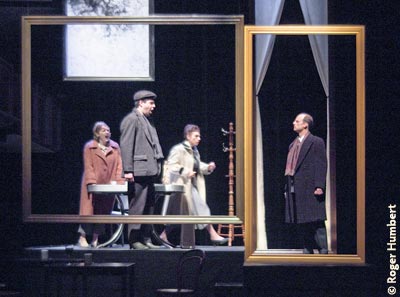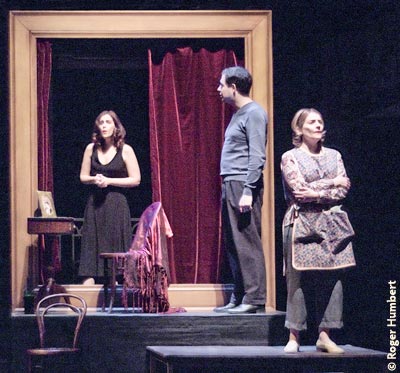
|
Inês
a new Canadian chamber opera presented by Queen of Puddings Music Theatre |
|
| February 25, 2009 • Enwave Theatre • Toronto |
|
|
|
|
|
|
Unrepentant Medieval Philanderers Sing So Lovely
Report by Tova G. Kardonne with photos by Roger Humbert |
| It’s just not opera unless the emotions in play are so enormous that a person simply must sing their troubles. Go on, Constanza, relieve your feelings with a really high note. There. Don’t we all feel better? Constanza did get a bad shake in this party, after all.
The title character, Inês, was a Galician noblewoman of the fourteenth century. She was handmaiden to the Princess of Spain, Constanza, who was betrothed to Prince Peter of Portugal. But the Prince fell in love with Inês instead, and every attempt by the King of Portugal to separate his son from Inês proved futile. Finally, the King had Inês killed, but, far from solving his wayward Prince problem, Peter declared that he had already married Ines in secret. He ordered her to be exhumed, dressed her in Queen’s clothes, and made the whole Portuguese court swear fealty to the dead body. Nobody cares what happened to Princess Constanza.
|
| And it’s all quite historical. These events truly happened in fourteenth century Portugal and they were represented anew at the Enwave Theatre but the creators, James Rolfe (composer) and Paul Bentley (librettist), set the scene in sixties Toronto. The whole thing is brought down the social ladder by several notches, too, revolving, not around royalty, but around Portuguese immigrants, a married couple, who flee to Canada when the husband, Pedro, deserts the Portuguese army. The wife, Constanza, was the daughter of a General in the Portuguese army, so she’s fractious about finding herself a lower-class working lady and uncongenial to her husband for landing her in this mess. When he seeks solace in a Portuguese fado bar where he meets the love of his life in the person of fado singer (or fadista) Inês, he decides to leave Constanza. Constanza writes home to Portugal and it just gets messier and messier until the in-laws are drinking Inês’ blood and everyone ends up dead and/or miserable. |
|

Inês Santos |
|
| It was amazing. It was really quite disturbing and totally icky at times, but also brilliant, truly. It must help that the voices at work were stunning. Constanza, played by soprano Shannon Mercer, attacked notes with a delicious lightness and a pure, tuned clarity that made it seem like a heavenly light beamed upon her every time she opened her mouth. The daring risk in this opera was the mixing of classical singers, and classical composition, with a real live Portuguese fadista singer — Inês was played by Portugal’s own Inês Santos, mistress of the traditional form. Were it I who was scheming to put these elements together, I would have been worried about blend between Mercer and Santos. But in the arias that brought them together in harmony, along with baritone Giles Tomkins, playing the wandering knave himself, the sweet overlap and counter-play of voices could not have been better managed. Never has the bitter-sweet revelation of an affair to one’s wife been so achingly, poignantly pleasing to the ear. There was one moment when I thought perhaps the challenging sensibilities of contemporary classical music may have proven a bit disorienting to Santos. Or perhaps those challenging sensibilities were a bit much for me; either way, a euphonious, tripping fado song about a blackbird, overset with chromatic lines that approach and retreat from the melody note in the same octave, made for a dangerous crunch, and while that imparted an effectively sinister cast to the scene, it seemed to sway the singer’s note off the centre of the pitch at times. |
| Other than that risky choice, the arrangements were incredibly beautiful. Guitars, bass, violin and woodwinds were carefully chosen to play to both the fado sound and provide a meaty, multi-tiered backdrop to the classical voices.
As for the story. While it was suitably dramatic for the opera and provided a rich and fertile ground for some undeniably impressive composition, I can’t help but rebel against an adaptation that contains the same narrative omission as the original telling of the history. That is to say, the traditional story of Inês is indifferent to the plight of the abandoned Princess Constanza. I would have accepted that in a tale set in the fourteenth century. I might even have accepted that if it were set entirely in a modern setting, as the story of a weak man in a difficult situation. But because the 60s-era characters frequently refer to the historical characters on which they are based, it seems to set up the abandonment of one’s wife for one’s lover as a time-honoured, and time-sanctioned, course of action. It was that, as much as the blood-drinking and bizarre familial relations that made it hard for me to really get down into the tragedy of it. A prince, under those circumstances, might truly be trapped in the hero’s fated downfall. A private citizen, on the other hand, appears more in the light of a jerk who’s not really trying to work it out.
|
|
|
|
| Still, I was on my feet at the end. Sung in English and acted pretty well (although it was quite clear that none of these singers were really prepared to hit anyone else on stage), the score was an amazing accomplishment, emotionally resonant and clever, deftly steering the fado and classical sounds in parallel to the illegitimate and legitimate relationships between the characters. All of the performers, in the pit and on the stage, inhabited the music superbly. And though it had been transplanted to the plebian plane, it retained all the intensity of a royal scandal. |
|
The Singers
Inês Santos, Giles Tomkins, Shannon Mercer, Elizabeth Turnbull, Thomas Goerz
Original music – James Rolfe
Original libretto – Paul Bentley
Jennifer Tarver – Stage director
Yannik Larivée – set & costume designer
Kimberly Purtell – lighting designer
Dáirine Ní Mheadhra and John Hess – co-artistic directors
|
|
|
|
|
|




